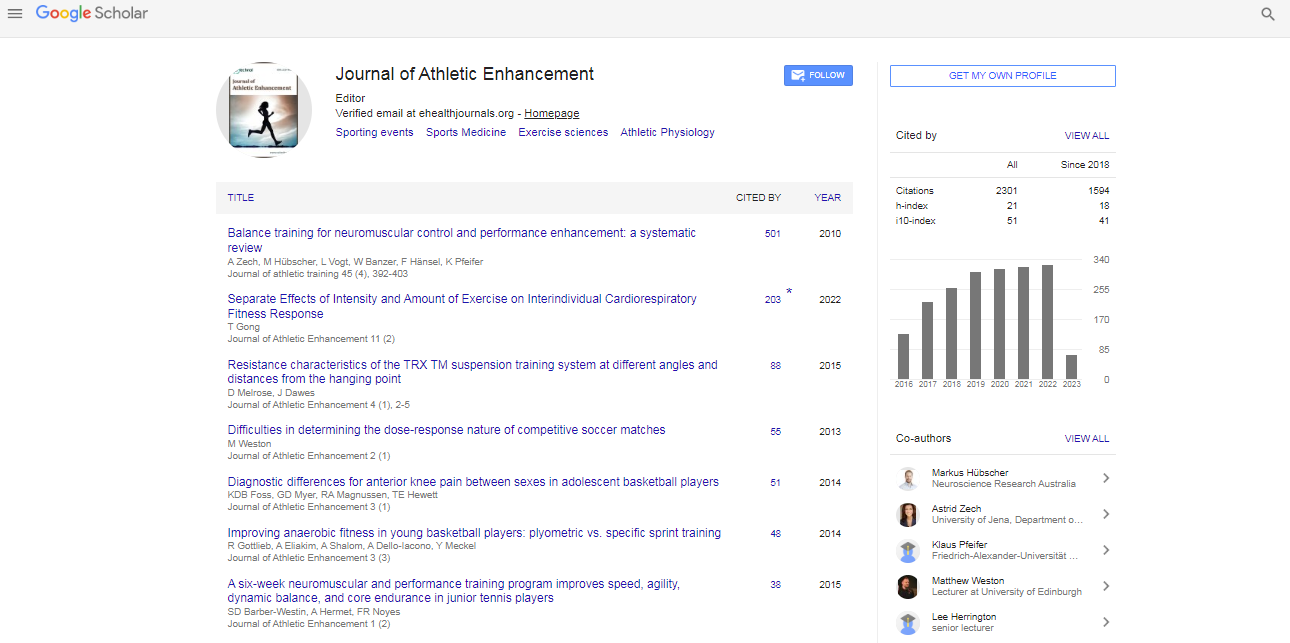Commentary, J Athl Enhanc Vol: 13 Issue: 4
Sports Doping: Challenges and Future Directions
Liam Hughes*
Department of Sport Science, Australian Institute of Sport, Bruce, Australia
*Corresponding Author: Liam Hughes,
Department of Sport Science, Australian
Institute of Sport, Bruce,
Australia;
E-mail: hughes_liam@gov.au
Received date: 28 June, 2024, Manuscript No. JAE-24-144903;
Editor assigned date: 01 July, 2024, PreQC No. JAE-24-144903 (PQ);
Reviewed date: 15 July, 2024, QC No. JAE-24-144903;
Revised date: 22 July, 2024, Manuscript No. JAE-24-144903 (R);
Published date: 29 July, 2024, DOI: 10.4172/2324-9080.1000136
Citation: Hughes L (2024) Sports Doping: Challenges and Future Directions. J Athl Enhanc 13:4.
Description
Sports doping is an important issue in the world of athletics, encompassing the use of Performance-Enhancing Drugs (PEDs) to gain an unfair advantage. This practice undermines the integrity of competitive sports, poses significant health risks to athletes and presents a complex challenge for regulators and policymakers.
Sports doping refers to the use of banned substances or methods to artificially enhance athletic performance. The World Anti-Doping Agency (WADA) defines doping as the use of drugs or methods that violate the spirit of sport, which includes enhancing performance, ensuring fairness and prioritizing the health of athletes. PEDs can include a variety of substances such as anabolic steroids, stimulants, hormones (like erythropoietin or human growth hormone) and diuretics, among others.
Several factors contribute to the prevalence of doping in sports. The intense pressure to win combined with the desire for fame, financial rewards and endorsements, can lead athletes to seek shortcuts to success. The competitive nature of modern sports often drives athletes to push their limits, sometimes leading them to resort to illegal substances to maintain or enhance their performance.
Moreover, the culture of winning at all costs, especially in highstakes competitions, can create an environment where doping is perceived as a necessary evil. In some cases, athletes may feel pressured by coaches, teammates, or sponsors to use PEDs to achieve their goals. The allure of immediate success and the fear of falling behind can cloud judgment, leading to risky decisions regarding substance use.
The consequences of doping extend beyond the immediate physical effects on athletes. Health risks associated with PEDs can be severe, including cardiovascular problems, liver damage, hormonal imbalances, psychological issues and increased susceptibility to infections. The long-term effects of many PEDs are still not fully understood, adding an additional layer of risk for those who use them.
Beyond personal health, doping undermines the integrity of sports. It erodes the principle of fair competition, as athletes who use PEDs gain an unfair advantage over their clean counterparts. This can lead to a loss of trust among fans, sponsors and other stakeholders, diminishing the credibility of the sport and its governing bodies. The impact on clean athletes who train hard and adhere to the rules can be particularly disheartening, as their efforts are overshadowed by those who cheat.
Challenges and future directions
Despite significant progress, challenges remain in the fight against doping. The evolving nature of PEDs and the constant development of new substances and methods pose on-going difficulties for regulators and testers. The temptation for athletes to use new, less detectable substances means that anti-doping agencies must continually adapt and refine their testing techniques.
Moreover, the global nature of sports doping requires international cooperation and consistent enforcement of regulations. Differences in anti-doping policies and enforcement practices between countries can create loopholes and inconsistencies, complicating efforts to maintain a level playing field.
Sports doping is a complex issue with far-reaching implications for athletes, sports organizations and society as a whole. Addressing doping requires a concerted effort from all stakeholders, including athletes, coaches, regulators and fans. By promoting clean competition, enforcing strict regulations and fostering a culture of integrity, the sports community can work towards a future where the spirit of fair play prevails and the health and well-being of athletes are safeguarded.
 Spanish
Spanish  Chinese
Chinese  Russian
Russian  German
German  French
French  Japanese
Japanese  Portuguese
Portuguese  Hindi
Hindi 
